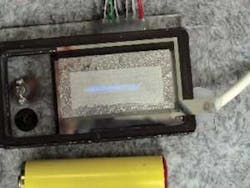Flashlights are handy things. With the advent of LEDs based on gallium nitride, near-UV flashlights have recently become available; they are useful for some forensic work, as well as seeing so-called “invisible ink.” But the far-UV region (approximately 200 to 280 nm), which has many uses in biology and chemistry, has remained off-limits to rugged, battery-powered handheld light sources, with only larger and more delicate mercury, deuterium, excimer, and xenon lamps serving as emitters.
Now, researchers at the National Institute for Materials Science (Ibaraki, Japan) and Futaba (Chiba, Japan) have combined field-emission cold cathodes with fluorescent hexagonal boron nitride (hBN) to create a far-UV source not much larger than a AA-size battery (see figure).1 The device, which can be battery-powered, can potentially be used in the field as well as the lab for catalysis, sterilization, and modification of chemical substances.
Fluorescent emitter
A cold cathode emits electrons at a low operating temperature and voltage, which makes it useful as an electron source in the fluorescent-tube backlights for liquid-crystal displays. When a cold cathode is combined with a visible fluorescent screen, the result is a pixel for a field-emission display (FED). However, the realization that hBN is an excellent fluorescent emitter of far-UV radiation is what drove the Japanese researchers to create a flashlight-sized version of an FED.
When excited by electrons, purified hBN emits in a strong peak centered at 225 nm; impurities and defects result in a much weaker tail extending to about 400 nm. The researchers constructed an hBN-powder-based FED array 1.6 × 17 mm in size and mounted it in a vacuum box with dimensions of 65 × 12 × 35 mm (the researchers say the box size was selected for convenience in fabrication and can be easily changed).
At an excitation voltage of 8 kV, the device stably emitted 0.2 mW of deep-UV light. At 9 kV, the output was 1 mW over several hours, with a quantum efficiency of 0.6% and no damage from maximum loading (a long-term 100-hour test at 6 kV showed a slight decrease in power, but this was due to degradation of the glass window as well as adsorption of residual gas on the surface of the fluorescent screen—both of which can be eliminated with better window material and evacuation to the level of that in a general FED production process). There was no thermal radiation, and thus no need for thermal blocking filters. The weak near-UV tail can be reduced by using hBN powders of higher quality.
The researchers also built a battery-operated version of their device. Created from commercial electronic parts and thus much larger than it could be if custom built, the emitter—which runs on four AA batteries—is 160 × 35 × 195 mm in size. If custom built, the emitter would be about the size of a mobile phone, say the researchers. The plane-emitting device produces a homogeneous light field that has advantages for potential quantitative measurements of far-UV-excited fluorescence over significant areas.
According to Kenji Watanabe, one of the National Institute for Materials Science researchers, the emitter can potentially be used as a sterilizing light source for methicillin-resistant staphylococcus aureus (MRSA), as a light source for rendering polychlorinated biphenyl (PCB) harmless, and more. He would like to experimentally prove its effectiveness for these uses, but to do so, he and his colleagues would need to collaborate with “experts in biology, physiology, chemistry, and so on,” says Watanabe. He is very interested in a collaboration, and hopes that the far-UV emitter will expand and enable applications that are currently limited by less-stable lamp sources.
REFERENCE
- K. Watanabe et al., Nature Photonics 3, p. 591 (October 2009).

